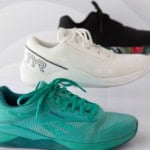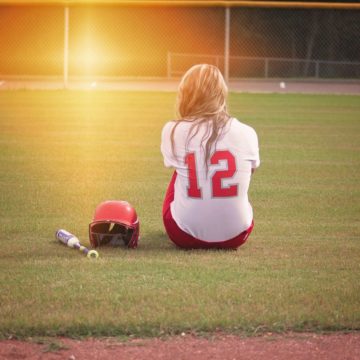
Including Cognitive Behavior Therapy, a psychological recovery piece, within injury recovery therapy creates a positive, whole-body healing environment. Here's what we mean:

For more tips for teen athletes, check out our posts on Signs and Symptoms of Iron Deficiency and The Best Carbohydrates for Teen Athletes.
Injuries On the Rise
The multi-sport athlete is becoming a thing of the past. Competitive seasons are becoming longer and our young athletes are practicing all year long for one sport. Because of this, evidence shows injuries are on the rise.
I was not resistant to this trend as a child. I held my first tennis racquet at 3 years old and I was hooked. My mother was a professional tennis player and, as my coach, we spent the majority of my childhood on the tennis court together, developing the fundamentals and skills of the sport. Weekends were rarely a time for relaxation, as we were constantly traveling the state for tournaments.
As I rose in the junior rankings, my confidence evolved and I felt that my success on the court began to define me. I thought my mom and I were unstoppable, until I hit my first speed bump as a young tennis player. During a tournament in south Florida, I sprinted for a short ball, sliding to stop myself before reaching the net. My front foot hit a shallow patch of clay and my ankle turned over. I couldn’t bear weight on my left leg as the pain and inflammation began to set it. The tournament was over for me. I had to withdraw, forfeiting the match so I could tend to my injured ankle.
More Than a Sprain
A sprained ankle can be detrimental to a tennis player, as stability in the ankles are key to handling the dynamic footwork and speed the sport requires. Fortunately, the sprain was minor and my ankle healed soon enough. The pain and swelling had subsided and I was ready to return to the court with my mom.
We worked on ground strokes initially, regaining the timing of the forehand and backhand. When I felt comfortable, my mom began to hit me some short balls. I rushed forward to meet the ball before the second bounce and hesitated. Let’s try again. My mom hit another one and, once again, I hesitated. I was worried my ankle would give out on me as I stepped into the ball.
I didn’t understand.
My ankle didn’t hurt, but my mind was stopping me from doing what needed to be done. I became extremely frustrated as the next few training sessions went similarly. The mental block I had affected my performance considerably, as I became more and more timid to chase down balls on the slippery clay. My mental and physical game suffered. A minor ankle sprain turned into weeks and months of missing tournaments and there was no concrete reason why.
Fear of Re-Injury and Return to Sport
Returning to competitive sport following an injury can be a daunting task, especially for our young athletes. In most cases with these young athletes, their first encounter with injury will be the toughest not only physically, but mentally.
The mindset of invincibility of a young athlete has its pros and cons.
On one hand, it can facilitate immense progress in their discipline, as growth is uninhibited by fear and doubt. On the other hand, it can build a false sense of invulnerability to injury and when injury occurs, as it inevitably will, that foundation of invulnerability is broken and can leave the athlete feeling exposed and unsure of their future in their sport.
Reality will set in: the body they have relied on for success, achievement, and victory has failed them. This realization is debilitating in many young athletes, as they naturally become more susceptible to breaks, sprains, and strains. Because of this, the road to injury recovery may be a bumpy one.
Psychological Factors
Psychological factors inhibit the mental and physical healing process and “When I return to play…” can unfortunately become “If I return to play…”.
Approximately 47% of athletes do not return to sport following injury and, out of this 47%, only 36% do not return due to lasting physical impairments.1
The assumption can be made that the remaining 64% are not returning to play due to a psychological barrier or fear of re-injury.
This fear of re-injury not only has psychological effects, but widespread physical ramifications including decreased muscular endurance and activation, altered muscle recruitment strategies, increasing likelihood of re-injury, decreased dynamic joint stability and range of motion, and delayed and improper tissue healing.2
As important as physical rehabilitation can be, the current model of rehabilitation focuses primarily on physical markers with minimal emphasis placed on psychological recovery.
By including Cognitive Behavior Therapy, a psychological recovery piece, within therapy, a positive, whole-body healing environment can be created.
What is Cognitive Behavioral Therapy?
Cognitive behavioral therapy, most commonly referred to as CBT, is a form of psychotherapy that uses specific principles to modify negative emotions, behavior, and thoughts.
This form of psychotherapy differs from conventional, Freudian psychotherapy in that it does not attempt to identify the root of negative emotions, but simply replace these negative emotions with positive ones.
Utilization of CBT is heavily researched in athletes and has been proven to enhance performance across the board. Unfortunately the efficacy of CBT’s impact on fear of re-injury and return to sport is limited. Therefore, there are minimal recommendations for the implementation of CBT in the rehabilitation of our athletes. In my practice, I attempt to find a standardized method of CBT through trial and error, and have found beneficial results in my young athletes. Let’s get to the specifics, shall we?
How to use CBT
Mental Practice
Mental practice involves the cognitive rehearsal of a task, typically used if an individual is unable to physically perform a task. With my athletes, I used mental practice prior to every new exercised performed.
I would have my athlete visualize exactly how the exercise should be performed, with an external focus rather than an internal focus.
For example, if the athlete was performing a box jump, they would simply visualize jumping from point A to point B, rather than focusing on the anatomical structures required to perform the box jump. This external focus solely on the outcome of the task been proven to increase performance while decreasing the emphasis placed on the physical strain of the exercise.3
Early on in the athlete’s rehabilitation, mental practice should be performed for 1 minute and slowly reduced in 15 minute increments, decreasing the reliance as the athlete progresses.
Positive Self-Talk
Negative thoughts flood the mind while recovering from injury and can be detrimental to progress. Replacing these negative thoughts is key to the athletes future performance. A professional golfer would never approach a putt thinking, “I’m going to miss this.” In their mind, they have accepted failure and the outcome will reflect that. This needs to be replaced with, “I am going to make this putt.”
Positive self-talk in athletes has actually been correlated with decreased anxiety, improved concentration and focus, and better performance in sport.4 So how can we transfer this practice of positive self-talk to our injured athletes? Positive self-talk can begin with a simple, general mantra:
Mantra
“I can do this.” The athlete should repeat this mantra whenever a new exercise or task is introduced. Their perspective on the task with change as they become mentally resilient to the possibility of hesitancy and failure. As the athlete progresses, their mantra can change, becoming more specific to their sport and the task at hand. Whatever they choose, it should be something they fully believe is achievable in order to bridge the gap between the perception of failure and success.
Graded Exposure
Release of the athlete back into their sport should be gradual, as to not overwhelm the athlete with challenging tasks outside of their capabilities. This graded exposure allows the athlete to build confidence in a progressive manner.
By breaking the sport down into components, variables can be manipulated and controlled, giving the athlete a sense of regulation over their environment. The components should increase in difficulty as the athlete builds confidence, with the goal of simulating the competitive environment and all variables anticipated just before the return to sport. As a coach or parent, be mindful of this and return an athlete back to play gradually.
Faded Feedback
We are constantly giving feedback to our young athletes. Feedback in the developing athlete is of utmost importance, but in the injured athlete, reliance on this feedback can be an issue. Movement will change with injury and normalizing movement though the rehabilitation process is always a priority.
In our young athletes, coaching and feedback will help build confidence in their movement as they begin to redevelop skills. In the beginning stages of returning to sport, feedback can be provided the majority of the time following an exercise or drill as the athlete will be very reliant on an outside perspective. But, as the athlete progresses, feedback should be given less and less. This faded feedback will give the athlete confidence that they no longer need validation for their performance.
Final Thoughts
So, what’s the common theme here?
Confidence.
Regaining confidence in our injured, young athletes should be a huge factor in their speedy and safe return to sport. The answer to this universal issue is the incorporation of mental exercises into rehabilitation. There needs to be change in the rehabilitation of these athletes, shifting from a heavy emphasis on just physical recovery to also including psychological recovery. Just like the body, the mind will adapt to consistent, progressive, and specific overload and can be highly effective with the use of CBT. I believe this additional training will increase the effectiveness of rehabilitation and have our young athletes return to sport mentally stronger than before their injury.
As a parent or coach you can work with your athlete on building confidence by implementing the techniques listed above.
Written by: Ray King

Special thanks to Dr. Sherry Pinkstaff, PhD, PT, DPT, for support in this topic.
References
- Kvist, J., Ek, A., Sporrstedt, K., & Good, L. (2005). Fear of re-injury: A hindrance for returning to sports after anterior cruciate ligament reconstruction. Knee Surgery, Sports Traumatology, Arthroscopy, 13(5), 393–397. http://doi.org/10.1007/s00167-004-0591-8
- Hsu, C., Meierbachtol, A., George, S. Z., & Chmielewski, T. L. (2016). Fear of Reinjury in Athletes. Sports Health: A Multidisciplinary Approach, 9(2), 162-167. doi:10.1177/1941738116666813.
- Marchant, David C; Greig, Matt; Scott, Catherine. Attentional Focusing Instructions Influence Force Production and Muscular Activity During Isokinetic Elbow Flexions. The Journal of Strength & Conditioning Research: November 2009 – Volume 23 – Issue 8 – p 2358-2366, DOI: 10.1519/JSC.0b013e3181b8d1e5
- Raalte, J. L., & Vincent, A. (2017). Self-Talk in Sport and Performance. Oxford Research Encyclopedia of Psychology. doi:10.1093/acrefore/9780190236557.013.157

















